Exploring Cultural and Social Factors in International Marketing
VerifiedAdded on 2023/01/06
|10
|2966
|86
Essay
AI Summary
This essay examines the crucial role of cultural and social factors in shaping international marketing strategies, emphasizing the "Think Global, Act Local" approach. It analyzes cultural differences like language, customs, and technology, highlighting the challenges companies face in adapting to local needs due to knowledge gaps. The study explores various international marketing strategies, including standardization and adaptation, using real-world examples like Aldi, Tesco, McDonald's, and Starbucks to illustrate successful implementation. It also addresses difficulties in adapting to local needs, such as cultural misunderstandings and ineffective negotiation, and suggests strategies for MNCs to enhance cultural relevance and navigate the complexities of global markets. Desklib provides this essay as a resource for students studying international marketing.
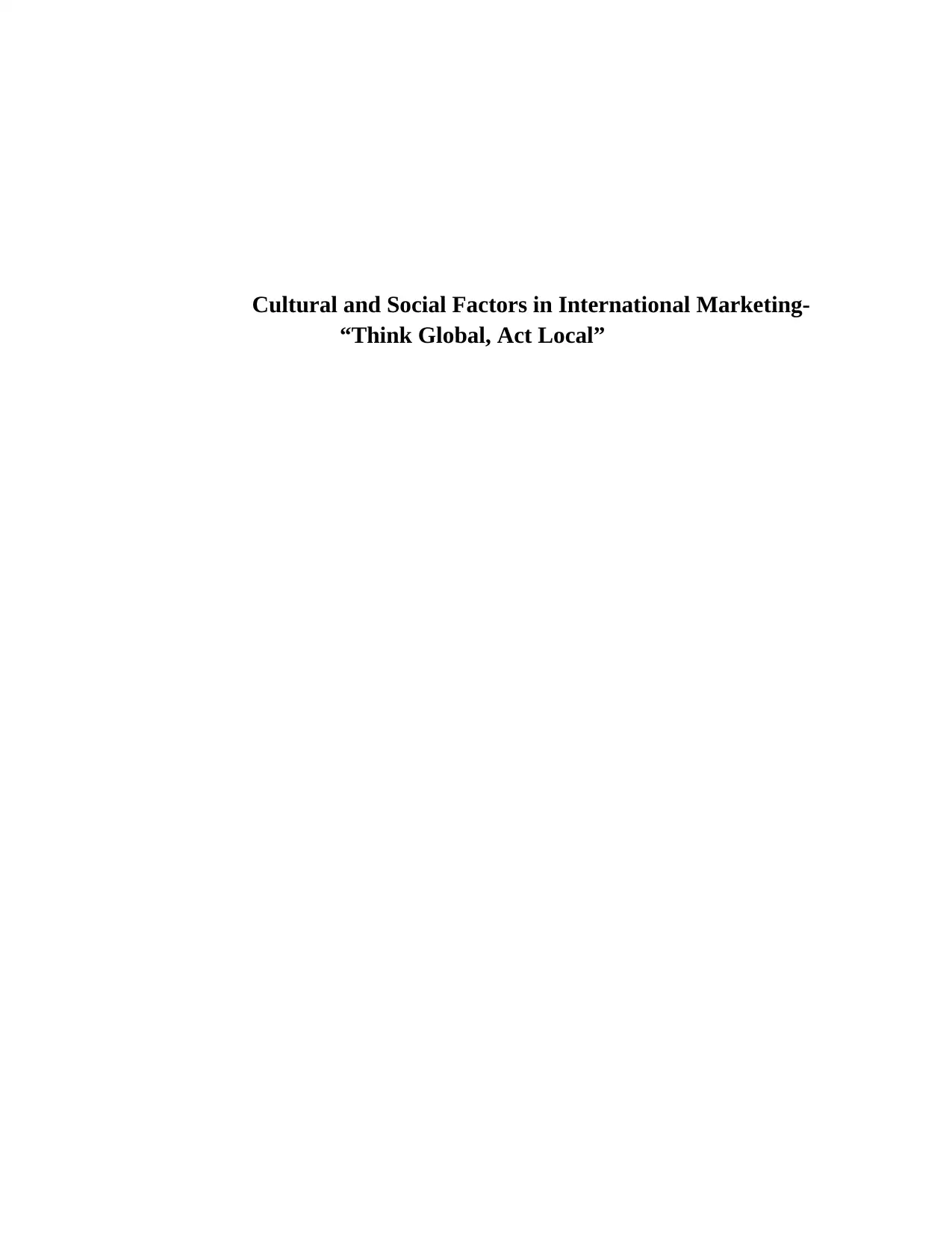
Cultural and Social Factors in International Marketing-
“Think Global, Act Local”
“Think Global, Act Local”
Paraphrase This Document
Need a fresh take? Get an instant paraphrase of this document with our AI Paraphraser
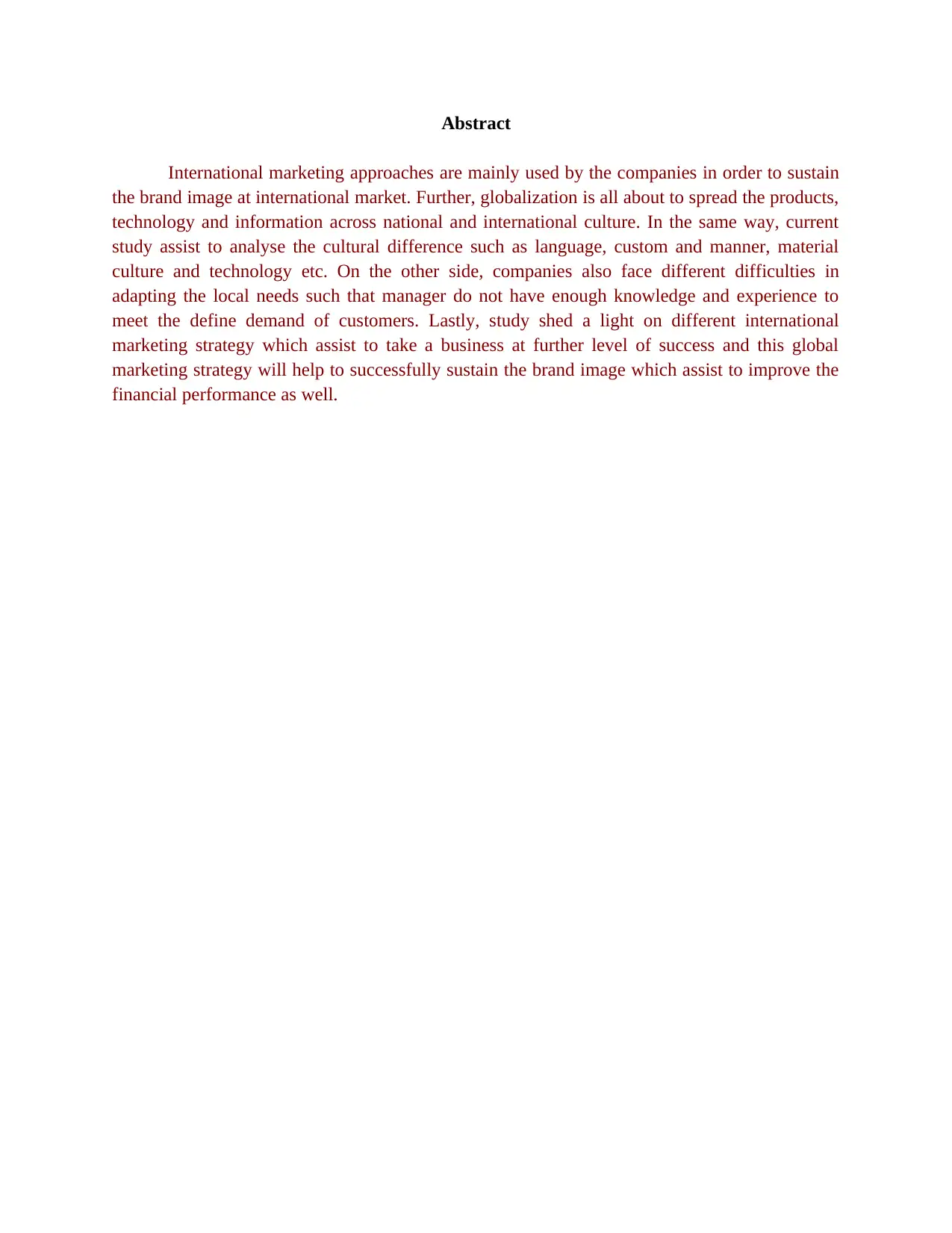
Abstract
International marketing approaches are mainly used by the companies in order to sustain
the brand image at international market. Further, globalization is all about to spread the products,
technology and information across national and international culture. In the same way, current
study assist to analyse the cultural difference such as language, custom and manner, material
culture and technology etc. On the other side, companies also face different difficulties in
adapting the local needs such that manager do not have enough knowledge and experience to
meet the define demand of customers. Lastly, study shed a light on different international
marketing strategy which assist to take a business at further level of success and this global
marketing strategy will help to successfully sustain the brand image which assist to improve the
financial performance as well.
International marketing approaches are mainly used by the companies in order to sustain
the brand image at international market. Further, globalization is all about to spread the products,
technology and information across national and international culture. In the same way, current
study assist to analyse the cultural difference such as language, custom and manner, material
culture and technology etc. On the other side, companies also face different difficulties in
adapting the local needs such that manager do not have enough knowledge and experience to
meet the define demand of customers. Lastly, study shed a light on different international
marketing strategy which assist to take a business at further level of success and this global
marketing strategy will help to successfully sustain the brand image which assist to improve the
financial performance as well.
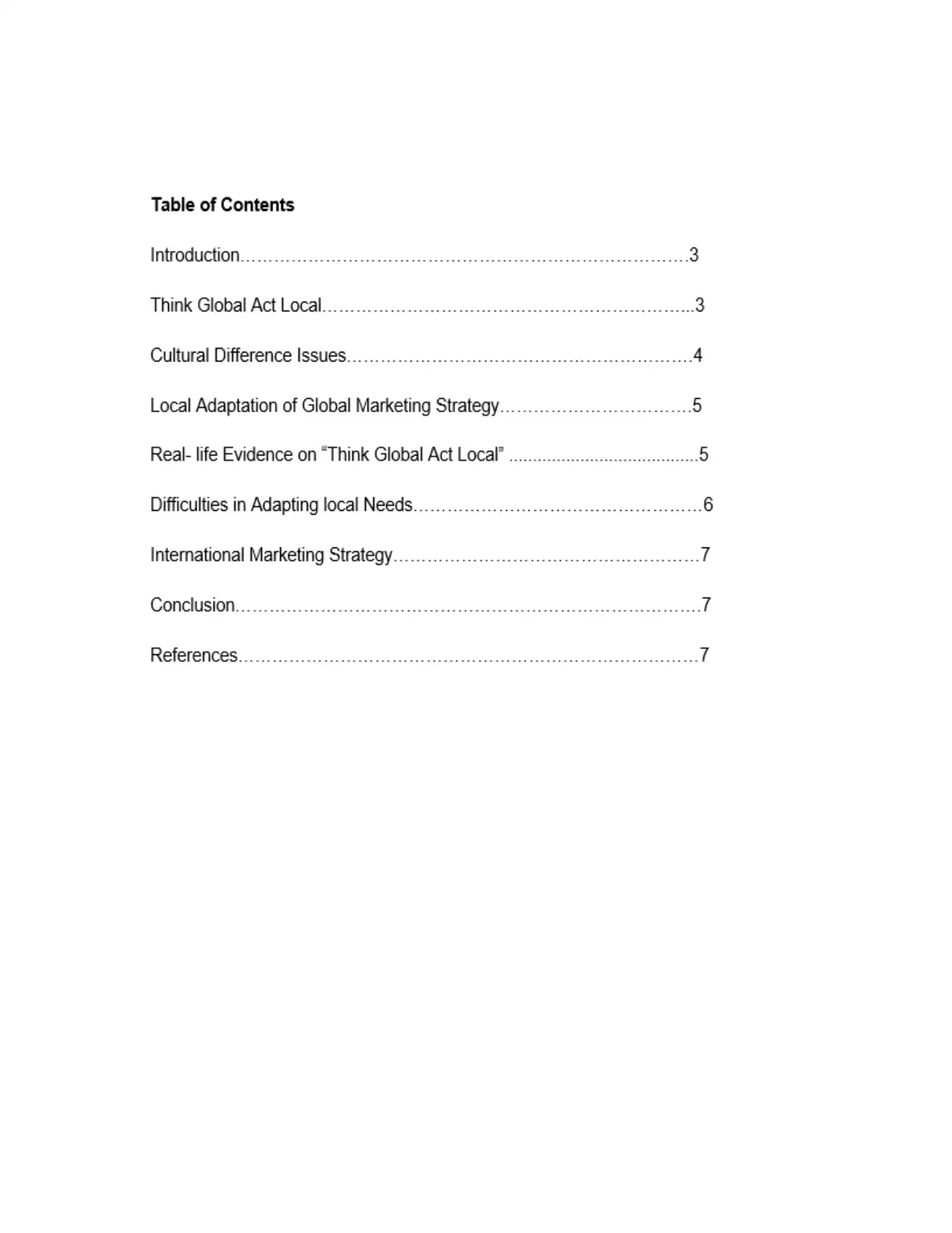
⊘ This is a preview!⊘
Do you want full access?
Subscribe today to unlock all pages.

Trusted by 1+ million students worldwide
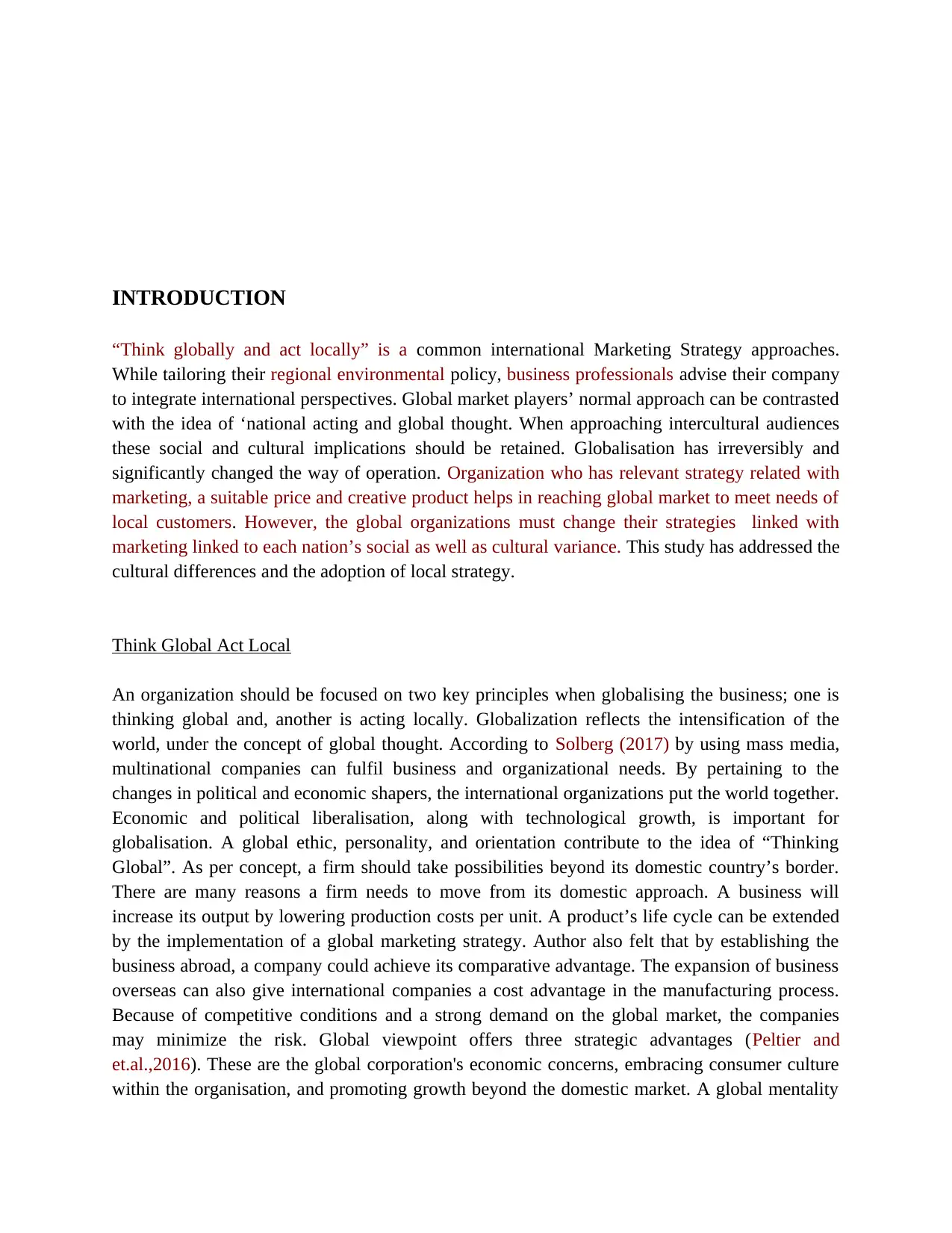
INTRODUCTION
“Think globally and act locally” is a common international Marketing Strategy approaches.
While tailoring their regional environmental policy, business professionals advise their company
to integrate international perspectives. Global market players’ normal approach can be contrasted
with the idea of ‘national acting and global thought. When approaching intercultural audiences
these social and cultural implications should be retained. Globalisation has irreversibly and
significantly changed the way of operation. Organization who has relevant strategy related with
marketing, a suitable price and creative product helps in reaching global market to meet needs of
local customers. However, the global organizations must change their strategies linked with
marketing linked to each nation’s social as well as cultural variance. This study has addressed the
cultural differences and the adoption of local strategy.
Think Global Act Local
An organization should be focused on two key principles when globalising the business; one is
thinking global and, another is acting locally. Globalization reflects the intensification of the
world, under the concept of global thought. According to Solberg (2017) by using mass media,
multinational companies can fulfil business and organizational needs. By pertaining to the
changes in political and economic shapers, the international organizations put the world together.
Economic and political liberalisation, along with technological growth, is important for
globalisation. A global ethic, personality, and orientation contribute to the idea of “Thinking
Global”. As per concept, a firm should take possibilities beyond its domestic country’s border.
There are many reasons a firm needs to move from its domestic approach. A business will
increase its output by lowering production costs per unit. A product’s life cycle can be extended
by the implementation of a global marketing strategy. Author also felt that by establishing the
business abroad, a company could achieve its comparative advantage. The expansion of business
overseas can also give international companies a cost advantage in the manufacturing process.
Because of competitive conditions and a strong demand on the global market, the companies
may minimize the risk. Global viewpoint offers three strategic advantages (Peltier and
et.al.,2016). These are the global corporation's economic concerns, embracing consumer culture
within the organisation, and promoting growth beyond the domestic market. A global mentality
“Think globally and act locally” is a common international Marketing Strategy approaches.
While tailoring their regional environmental policy, business professionals advise their company
to integrate international perspectives. Global market players’ normal approach can be contrasted
with the idea of ‘national acting and global thought. When approaching intercultural audiences
these social and cultural implications should be retained. Globalisation has irreversibly and
significantly changed the way of operation. Organization who has relevant strategy related with
marketing, a suitable price and creative product helps in reaching global market to meet needs of
local customers. However, the global organizations must change their strategies linked with
marketing linked to each nation’s social as well as cultural variance. This study has addressed the
cultural differences and the adoption of local strategy.
Think Global Act Local
An organization should be focused on two key principles when globalising the business; one is
thinking global and, another is acting locally. Globalization reflects the intensification of the
world, under the concept of global thought. According to Solberg (2017) by using mass media,
multinational companies can fulfil business and organizational needs. By pertaining to the
changes in political and economic shapers, the international organizations put the world together.
Economic and political liberalisation, along with technological growth, is important for
globalisation. A global ethic, personality, and orientation contribute to the idea of “Thinking
Global”. As per concept, a firm should take possibilities beyond its domestic country’s border.
There are many reasons a firm needs to move from its domestic approach. A business will
increase its output by lowering production costs per unit. A product’s life cycle can be extended
by the implementation of a global marketing strategy. Author also felt that by establishing the
business abroad, a company could achieve its comparative advantage. The expansion of business
overseas can also give international companies a cost advantage in the manufacturing process.
Because of competitive conditions and a strong demand on the global market, the companies
may minimize the risk. Global viewpoint offers three strategic advantages (Peltier and
et.al.,2016). These are the global corporation's economic concerns, embracing consumer culture
within the organisation, and promoting growth beyond the domestic market. A global mentality
Paraphrase This Document
Need a fresh take? Get an instant paraphrase of this document with our AI Paraphraser
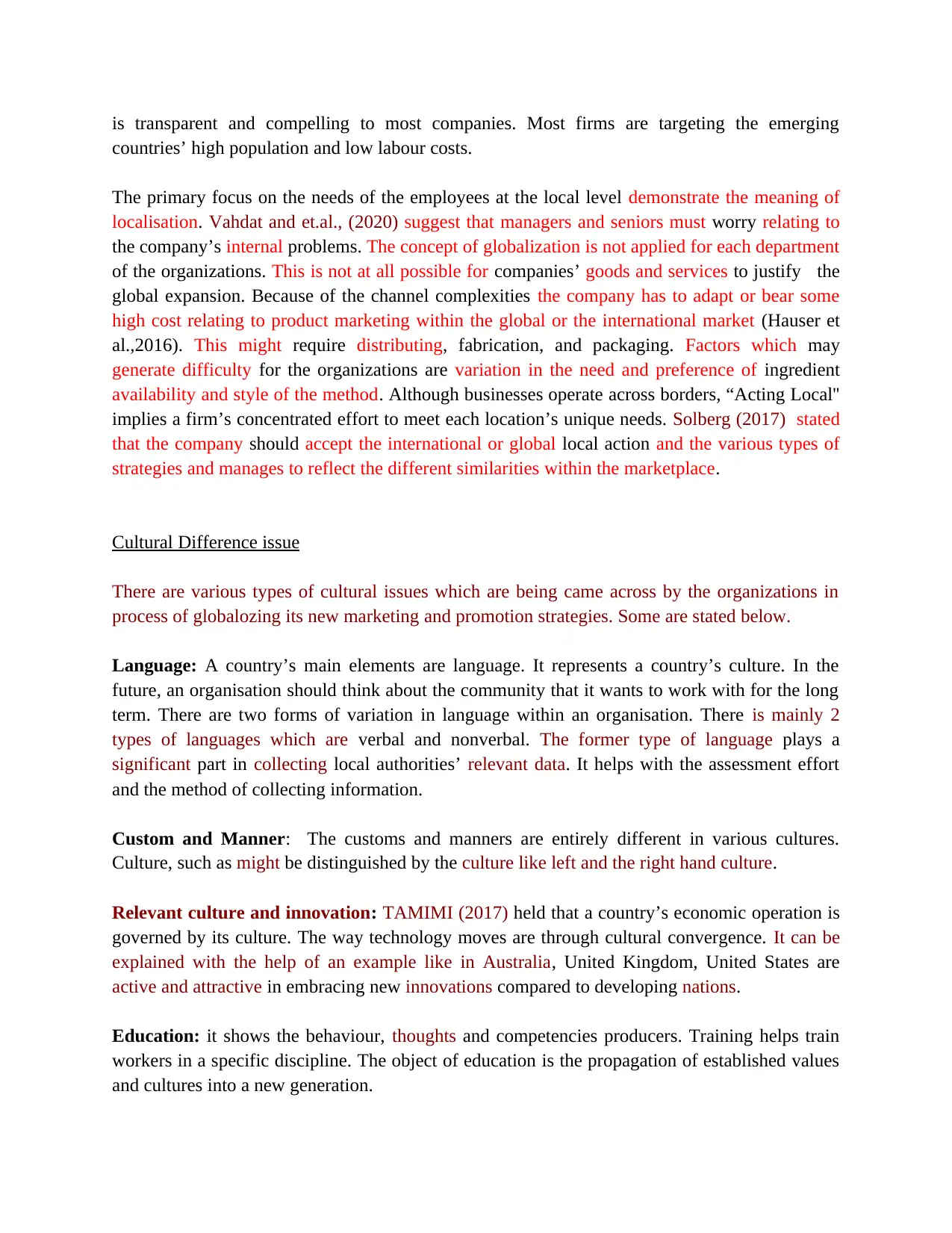
is transparent and compelling to most companies. Most firms are targeting the emerging
countries’ high population and low labour costs.
The primary focus on the needs of the employees at the local level demonstrate the meaning of
localisation. Vahdat and et.al., (2020) suggest that managers and seniors must worry relating to
the company’s internal problems. The concept of globalization is not applied for each department
of the organizations. This is not at all possible for companies’ goods and services to justify the
global expansion. Because of the channel complexities the company has to adapt or bear some
high cost relating to product marketing within the global or the international market (Hauser et
al.,2016). This might require distributing, fabrication, and packaging. Factors which may
generate difficulty for the organizations are variation in the need and preference of ingredient
availability and style of the method. Although businesses operate across borders, “Acting Local''
implies a firm’s concentrated effort to meet each location’s unique needs. Solberg (2017) stated
that the company should accept the international or global local action and the various types of
strategies and manages to reflect the different similarities within the marketplace.
Cultural Difference issue
There are various types of cultural issues which are being came across by the organizations in
process of globalozing its new marketing and promotion strategies. Some are stated below.
Language: A country’s main elements are language. It represents a country’s culture. In the
future, an organisation should think about the community that it wants to work with for the long
term. There are two forms of variation in language within an organisation. There is mainly 2
types of languages which are verbal and nonverbal. The former type of language plays a
significant part in collecting local authorities’ relevant data. It helps with the assessment effort
and the method of collecting information.
Custom and Manner: The customs and manners are entirely different in various cultures.
Culture, such as might be distinguished by the culture like left and the right hand culture.
Relevant culture and innovation: TAMIMI (2017) held that a country’s economic operation is
governed by its culture. The way technology moves are through cultural convergence. It can be
explained with the help of an example like in Australia, United Kingdom, United States are
active and attractive in embracing new innovations compared to developing nations.
Education: it shows the behaviour, thoughts and competencies producers. Training helps train
workers in a specific discipline. The object of education is the propagation of established values
and cultures into a new generation.
countries’ high population and low labour costs.
The primary focus on the needs of the employees at the local level demonstrate the meaning of
localisation. Vahdat and et.al., (2020) suggest that managers and seniors must worry relating to
the company’s internal problems. The concept of globalization is not applied for each department
of the organizations. This is not at all possible for companies’ goods and services to justify the
global expansion. Because of the channel complexities the company has to adapt or bear some
high cost relating to product marketing within the global or the international market (Hauser et
al.,2016). This might require distributing, fabrication, and packaging. Factors which may
generate difficulty for the organizations are variation in the need and preference of ingredient
availability and style of the method. Although businesses operate across borders, “Acting Local''
implies a firm’s concentrated effort to meet each location’s unique needs. Solberg (2017) stated
that the company should accept the international or global local action and the various types of
strategies and manages to reflect the different similarities within the marketplace.
Cultural Difference issue
There are various types of cultural issues which are being came across by the organizations in
process of globalozing its new marketing and promotion strategies. Some are stated below.
Language: A country’s main elements are language. It represents a country’s culture. In the
future, an organisation should think about the community that it wants to work with for the long
term. There are two forms of variation in language within an organisation. There is mainly 2
types of languages which are verbal and nonverbal. The former type of language plays a
significant part in collecting local authorities’ relevant data. It helps with the assessment effort
and the method of collecting information.
Custom and Manner: The customs and manners are entirely different in various cultures.
Culture, such as might be distinguished by the culture like left and the right hand culture.
Relevant culture and innovation: TAMIMI (2017) held that a country’s economic operation is
governed by its culture. The way technology moves are through cultural convergence. It can be
explained with the help of an example like in Australia, United Kingdom, United States are
active and attractive in embracing new innovations compared to developing nations.
Education: it shows the behaviour, thoughts and competencies producers. Training helps train
workers in a specific discipline. The object of education is the propagation of established values
and cultures into a new generation.
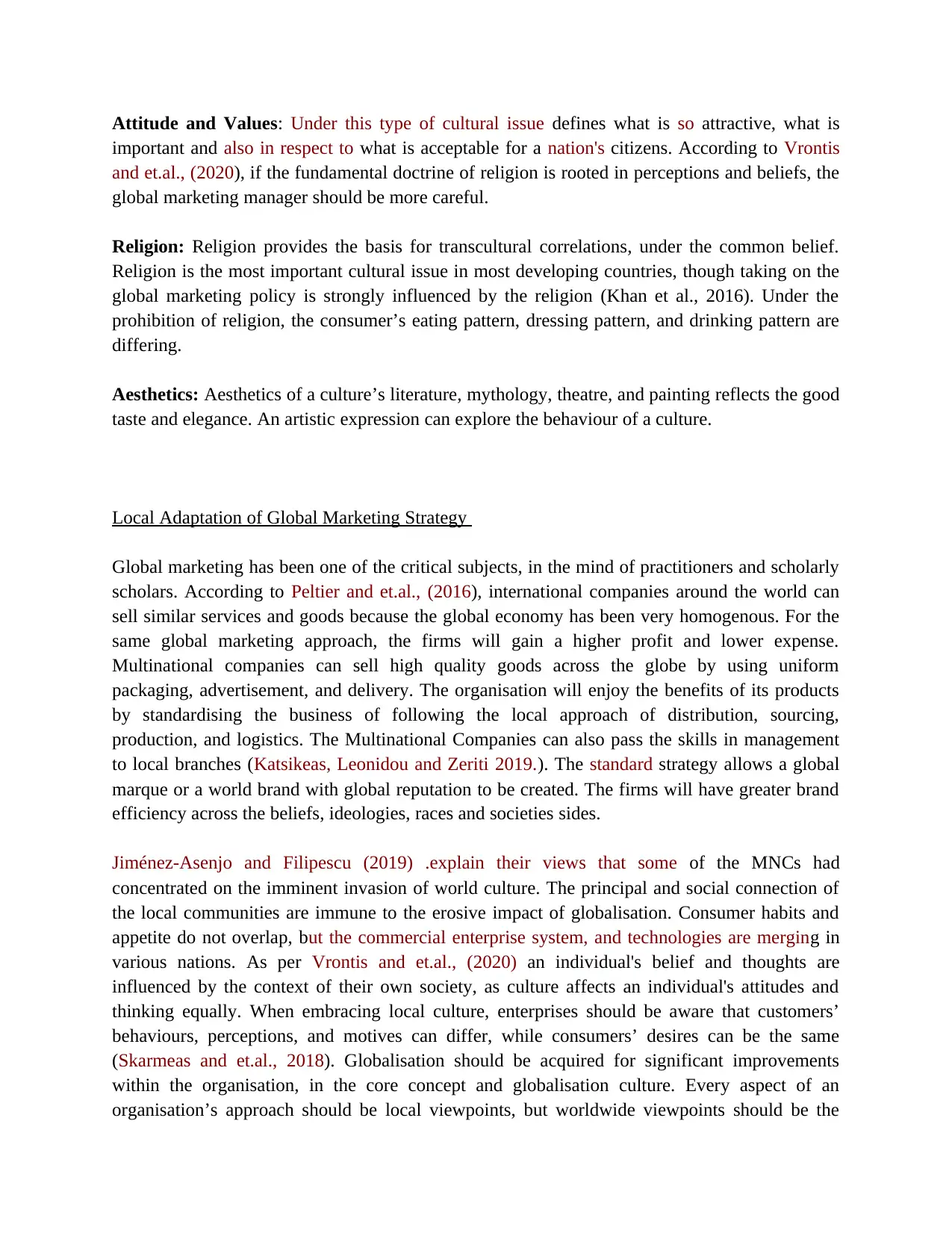
Attitude and Values: Under this type of cultural issue defines what is so attractive, what is
important and also in respect to what is acceptable for a nation's citizens. According to Vrontis
and et.al., (2020), if the fundamental doctrine of religion is rooted in perceptions and beliefs, the
global marketing manager should be more careful.
Religion: Religion provides the basis for transcultural correlations, under the common belief.
Religion is the most important cultural issue in most developing countries, though taking on the
global marketing policy is strongly influenced by the religion (Khan et al., 2016). Under the
prohibition of religion, the consumer’s eating pattern, dressing pattern, and drinking pattern are
differing.
Aesthetics: Aesthetics of a culture’s literature, mythology, theatre, and painting reflects the good
taste and elegance. An artistic expression can explore the behaviour of a culture.
Local Adaptation of Global Marketing Strategy
Global marketing has been one of the critical subjects, in the mind of practitioners and scholarly
scholars. According to Peltier and et.al., (2016), international companies around the world can
sell similar services and goods because the global economy has been very homogenous. For the
same global marketing approach, the firms will gain a higher profit and lower expense.
Multinational companies can sell high quality goods across the globe by using uniform
packaging, advertisement, and delivery. The organisation will enjoy the benefits of its products
by standardising the business of following the local approach of distribution, sourcing,
production, and logistics. The Multinational Companies can also pass the skills in management
to local branches (Katsikeas, Leonidou and Zeriti 2019.). The standard strategy allows a global
marque or a world brand with global reputation to be created. The firms will have greater brand
efficiency across the beliefs, ideologies, races and societies sides.
Jiménez-Asenjo and Filipescu (2019) .explain their views that some of the MNCs had
concentrated on the imminent invasion of world culture. The principal and social connection of
the local communities are immune to the erosive impact of globalisation. Consumer habits and
appetite do not overlap, but the commercial enterprise system, and technologies are merging in
various nations. As per Vrontis and et.al., (2020) an individual's belief and thoughts are
influenced by the context of their own society, as culture affects an individual's attitudes and
thinking equally. When embracing local culture, enterprises should be aware that customers’
behaviours, perceptions, and motives can differ, while consumers’ desires can be the same
(Skarmeas and et.al., 2018). Globalisation should be acquired for significant improvements
within the organisation, in the core concept and globalisation culture. Every aspect of an
organisation’s approach should be local viewpoints, but worldwide viewpoints should be the
important and also in respect to what is acceptable for a nation's citizens. According to Vrontis
and et.al., (2020), if the fundamental doctrine of religion is rooted in perceptions and beliefs, the
global marketing manager should be more careful.
Religion: Religion provides the basis for transcultural correlations, under the common belief.
Religion is the most important cultural issue in most developing countries, though taking on the
global marketing policy is strongly influenced by the religion (Khan et al., 2016). Under the
prohibition of religion, the consumer’s eating pattern, dressing pattern, and drinking pattern are
differing.
Aesthetics: Aesthetics of a culture’s literature, mythology, theatre, and painting reflects the good
taste and elegance. An artistic expression can explore the behaviour of a culture.
Local Adaptation of Global Marketing Strategy
Global marketing has been one of the critical subjects, in the mind of practitioners and scholarly
scholars. According to Peltier and et.al., (2016), international companies around the world can
sell similar services and goods because the global economy has been very homogenous. For the
same global marketing approach, the firms will gain a higher profit and lower expense.
Multinational companies can sell high quality goods across the globe by using uniform
packaging, advertisement, and delivery. The organisation will enjoy the benefits of its products
by standardising the business of following the local approach of distribution, sourcing,
production, and logistics. The Multinational Companies can also pass the skills in management
to local branches (Katsikeas, Leonidou and Zeriti 2019.). The standard strategy allows a global
marque or a world brand with global reputation to be created. The firms will have greater brand
efficiency across the beliefs, ideologies, races and societies sides.
Jiménez-Asenjo and Filipescu (2019) .explain their views that some of the MNCs had
concentrated on the imminent invasion of world culture. The principal and social connection of
the local communities are immune to the erosive impact of globalisation. Consumer habits and
appetite do not overlap, but the commercial enterprise system, and technologies are merging in
various nations. As per Vrontis and et.al., (2020) an individual's belief and thoughts are
influenced by the context of their own society, as culture affects an individual's attitudes and
thinking equally. When embracing local culture, enterprises should be aware that customers’
behaviours, perceptions, and motives can differ, while consumers’ desires can be the same
(Skarmeas and et.al., 2018). Globalisation should be acquired for significant improvements
within the organisation, in the core concept and globalisation culture. Every aspect of an
organisation’s approach should be local viewpoints, but worldwide viewpoints should be the
⊘ This is a preview!⊘
Do you want full access?
Subscribe today to unlock all pages.

Trusted by 1+ million students worldwide
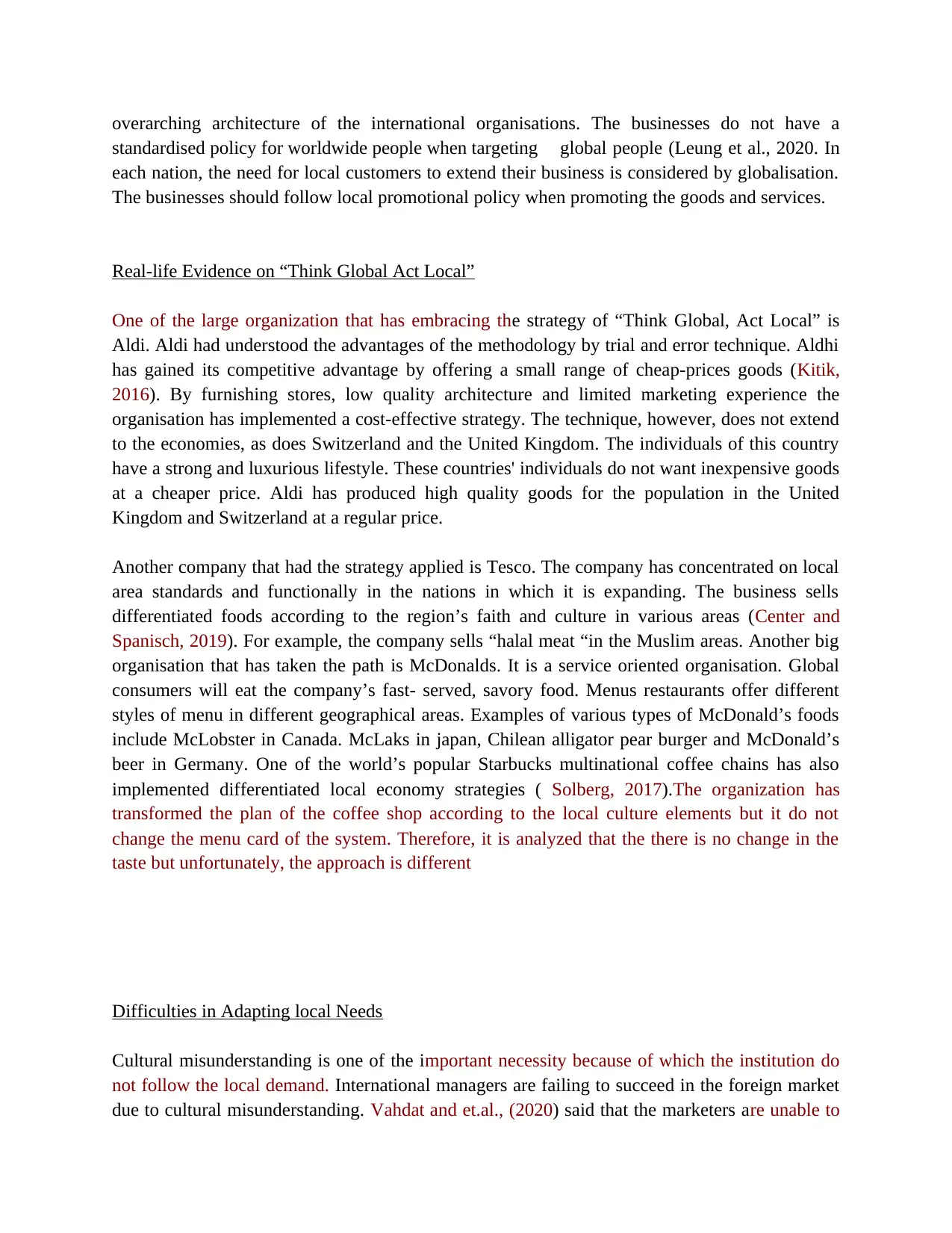
overarching architecture of the international organisations. The businesses do not have a
standardised policy for worldwide people when targeting global people (Leung et al., 2020. In
each nation, the need for local customers to extend their business is considered by globalisation.
The businesses should follow local promotional policy when promoting the goods and services.
Real-life Evidence on “Think Global Act Local”
One of the large organization that has embracing the strategy of “Think Global, Act Local” is
Aldi. Aldi had understood the advantages of the methodology by trial and error technique. Aldhi
has gained its competitive advantage by offering a small range of cheap-prices goods (Kitik,
2016). By furnishing stores, low quality architecture and limited marketing experience the
organisation has implemented a cost-effective strategy. The technique, however, does not extend
to the economies, as does Switzerland and the United Kingdom. The individuals of this country
have a strong and luxurious lifestyle. These countries' individuals do not want inexpensive goods
at a cheaper price. Aldi has produced high quality goods for the population in the United
Kingdom and Switzerland at a regular price.
Another company that had the strategy applied is Tesco. The company has concentrated on local
area standards and functionally in the nations in which it is expanding. The business sells
differentiated foods according to the region’s faith and culture in various areas (Center and
Spanisch, 2019). For example, the company sells “halal meat “in the Muslim areas. Another big
organisation that has taken the path is McDonalds. It is a service oriented organisation. Global
consumers will eat the company’s fast- served, savory food. Menus restaurants offer different
styles of menu in different geographical areas. Examples of various types of McDonald’s foods
include McLobster in Canada. McLaks in japan, Chilean alligator pear burger and McDonald’s
beer in Germany. One of the world’s popular Starbucks multinational coffee chains has also
implemented differentiated local economy strategies ( Solberg, 2017).The organization has
transformed the plan of the coffee shop according to the local culture elements but it do not
change the menu card of the system. Therefore, it is analyzed that the there is no change in the
taste but unfortunately, the approach is different
Difficulties in Adapting local Needs
Cultural misunderstanding is one of the important necessity because of which the institution do
not follow the local demand. International managers are failing to succeed in the foreign market
due to cultural misunderstanding. Vahdat and et.al., (2020) said that the marketers are unable to
standardised policy for worldwide people when targeting global people (Leung et al., 2020. In
each nation, the need for local customers to extend their business is considered by globalisation.
The businesses should follow local promotional policy when promoting the goods and services.
Real-life Evidence on “Think Global Act Local”
One of the large organization that has embracing the strategy of “Think Global, Act Local” is
Aldi. Aldi had understood the advantages of the methodology by trial and error technique. Aldhi
has gained its competitive advantage by offering a small range of cheap-prices goods (Kitik,
2016). By furnishing stores, low quality architecture and limited marketing experience the
organisation has implemented a cost-effective strategy. The technique, however, does not extend
to the economies, as does Switzerland and the United Kingdom. The individuals of this country
have a strong and luxurious lifestyle. These countries' individuals do not want inexpensive goods
at a cheaper price. Aldi has produced high quality goods for the population in the United
Kingdom and Switzerland at a regular price.
Another company that had the strategy applied is Tesco. The company has concentrated on local
area standards and functionally in the nations in which it is expanding. The business sells
differentiated foods according to the region’s faith and culture in various areas (Center and
Spanisch, 2019). For example, the company sells “halal meat “in the Muslim areas. Another big
organisation that has taken the path is McDonalds. It is a service oriented organisation. Global
consumers will eat the company’s fast- served, savory food. Menus restaurants offer different
styles of menu in different geographical areas. Examples of various types of McDonald’s foods
include McLobster in Canada. McLaks in japan, Chilean alligator pear burger and McDonald’s
beer in Germany. One of the world’s popular Starbucks multinational coffee chains has also
implemented differentiated local economy strategies ( Solberg, 2017).The organization has
transformed the plan of the coffee shop according to the local culture elements but it do not
change the menu card of the system. Therefore, it is analyzed that the there is no change in the
taste but unfortunately, the approach is different
Difficulties in Adapting local Needs
Cultural misunderstanding is one of the important necessity because of which the institution do
not follow the local demand. International managers are failing to succeed in the foreign market
due to cultural misunderstanding. Vahdat and et.al., (2020) said that the marketers are unable to
Paraphrase This Document
Need a fresh take? Get an instant paraphrase of this document with our AI Paraphraser
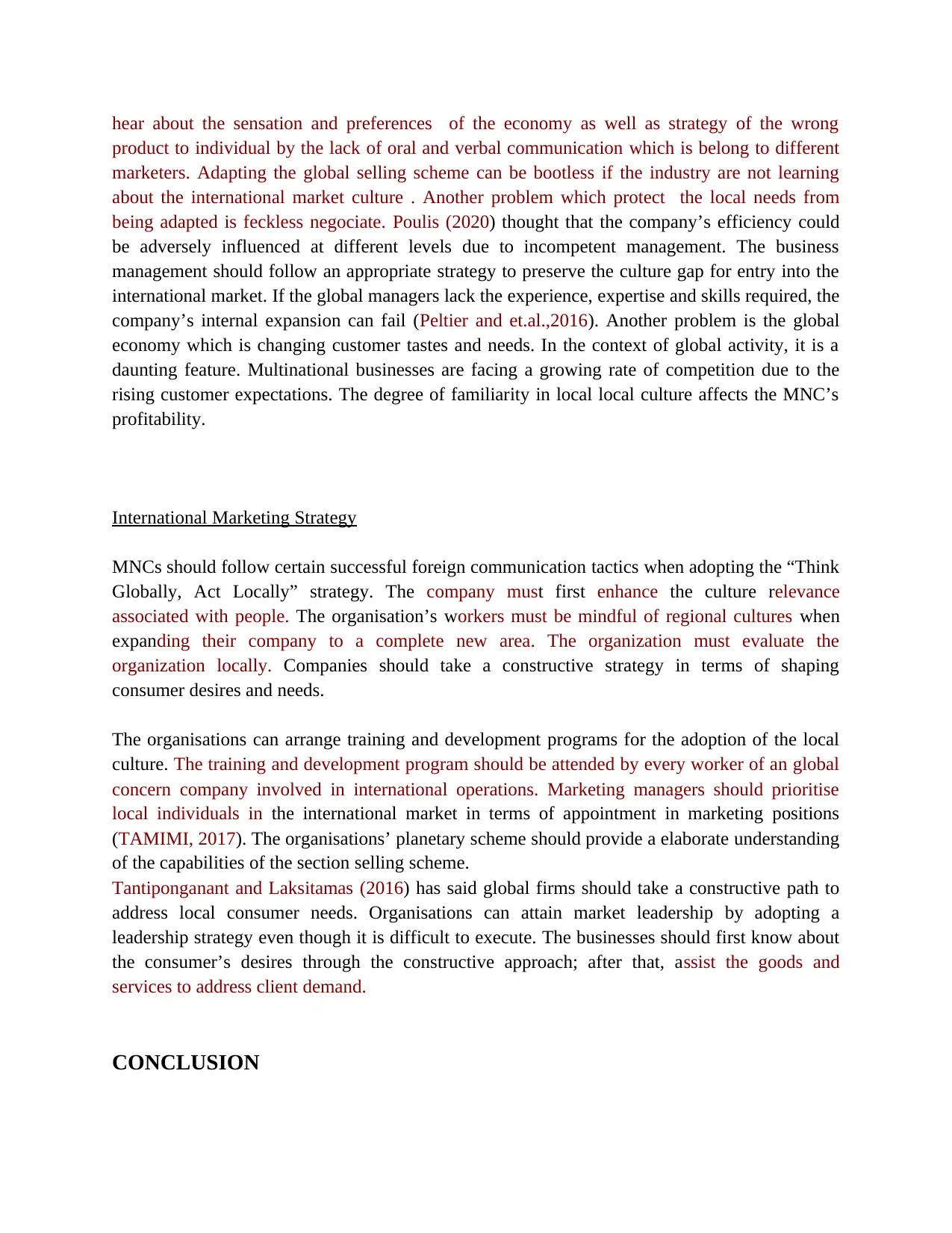
hear about the sensation and preferences of the economy as well as strategy of the wrong
product to individual by the lack of oral and verbal communication which is belong to different
marketers. Adapting the global selling scheme can be bootless if the industry are not learning
about the international market culture . Another problem which protect the local needs from
being adapted is feckless negociate. Poulis (2020) thought that the company’s efficiency could
be adversely influenced at different levels due to incompetent management. The business
management should follow an appropriate strategy to preserve the culture gap for entry into the
international market. If the global managers lack the experience, expertise and skills required, the
company’s internal expansion can fail (Peltier and et.al.,2016). Another problem is the global
economy which is changing customer tastes and needs. In the context of global activity, it is a
daunting feature. Multinational businesses are facing a growing rate of competition due to the
rising customer expectations. The degree of familiarity in local local culture affects the MNC’s
profitability.
International Marketing Strategy
MNCs should follow certain successful foreign communication tactics when adopting the “Think
Globally, Act Locally” strategy. The company must first enhance the culture relevance
associated with people. The organisation’s workers must be mindful of regional cultures when
expanding their company to a complete new area. The organization must evaluate the
organization locally. Companies should take a constructive strategy in terms of shaping
consumer desires and needs.
The organisations can arrange training and development programs for the adoption of the local
culture. The training and development program should be attended by every worker of an global
concern company involved in international operations. Marketing managers should prioritise
local individuals in the international market in terms of appointment in marketing positions
(TAMIMI, 2017). The organisations’ planetary scheme should provide a elaborate understanding
of the capabilities of the section selling scheme.
Tantiponganant and Laksitamas (2016) has said global firms should take a constructive path to
address local consumer needs. Organisations can attain market leadership by adopting a
leadership strategy even though it is difficult to execute. The businesses should first know about
the consumer’s desires through the constructive approach; after that, assist the goods and
services to address client demand.
CONCLUSION
product to individual by the lack of oral and verbal communication which is belong to different
marketers. Adapting the global selling scheme can be bootless if the industry are not learning
about the international market culture . Another problem which protect the local needs from
being adapted is feckless negociate. Poulis (2020) thought that the company’s efficiency could
be adversely influenced at different levels due to incompetent management. The business
management should follow an appropriate strategy to preserve the culture gap for entry into the
international market. If the global managers lack the experience, expertise and skills required, the
company’s internal expansion can fail (Peltier and et.al.,2016). Another problem is the global
economy which is changing customer tastes and needs. In the context of global activity, it is a
daunting feature. Multinational businesses are facing a growing rate of competition due to the
rising customer expectations. The degree of familiarity in local local culture affects the MNC’s
profitability.
International Marketing Strategy
MNCs should follow certain successful foreign communication tactics when adopting the “Think
Globally, Act Locally” strategy. The company must first enhance the culture relevance
associated with people. The organisation’s workers must be mindful of regional cultures when
expanding their company to a complete new area. The organization must evaluate the
organization locally. Companies should take a constructive strategy in terms of shaping
consumer desires and needs.
The organisations can arrange training and development programs for the adoption of the local
culture. The training and development program should be attended by every worker of an global
concern company involved in international operations. Marketing managers should prioritise
local individuals in the international market in terms of appointment in marketing positions
(TAMIMI, 2017). The organisations’ planetary scheme should provide a elaborate understanding
of the capabilities of the section selling scheme.
Tantiponganant and Laksitamas (2016) has said global firms should take a constructive path to
address local consumer needs. Organisations can attain market leadership by adopting a
leadership strategy even though it is difficult to execute. The businesses should first know about
the consumer’s desires through the constructive approach; after that, assist the goods and
services to address client demand.
CONCLUSION
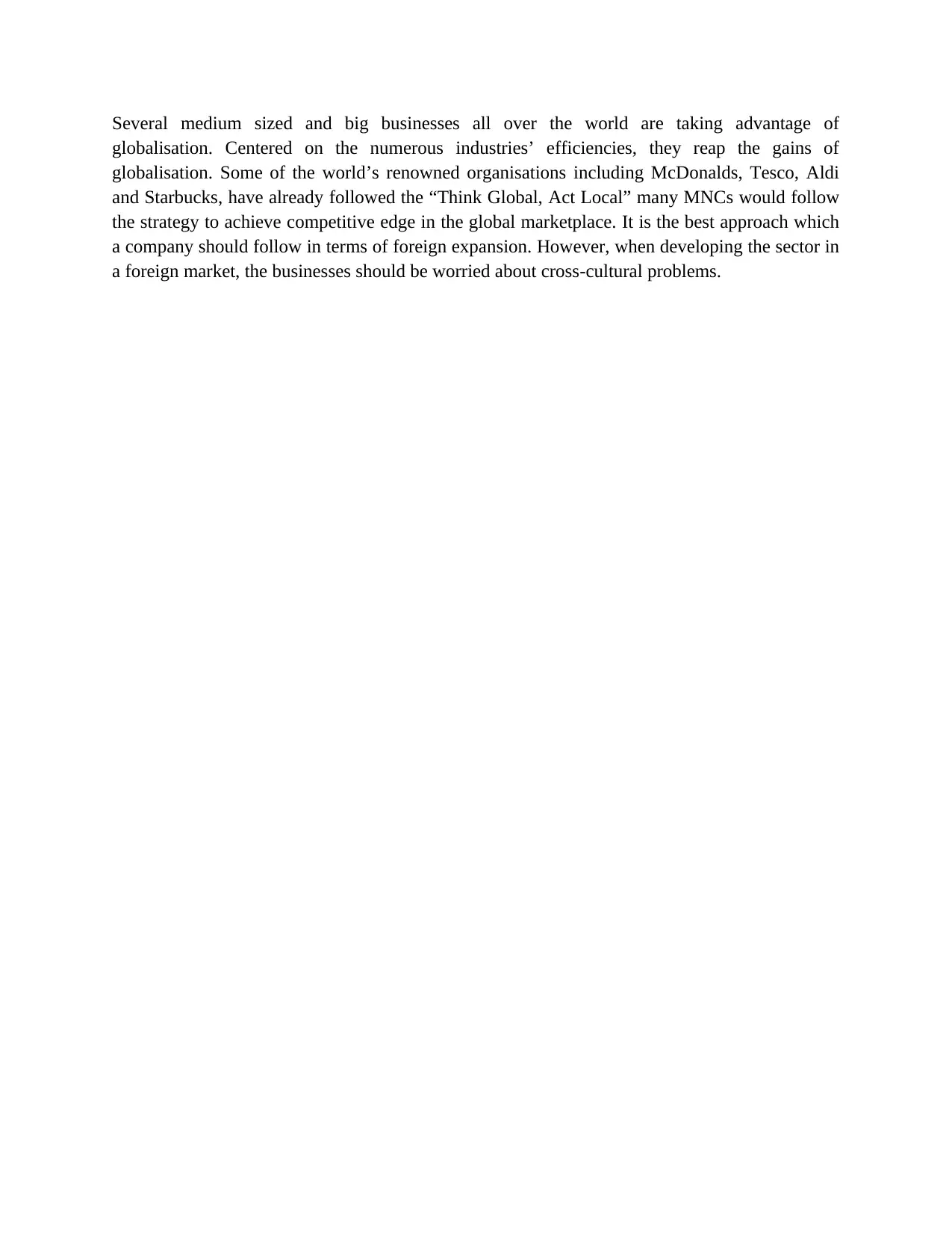
Several medium sized and big businesses all over the world are taking advantage of
globalisation. Centered on the numerous industries’ efficiencies, they reap the gains of
globalisation. Some of the world’s renowned organisations including McDonalds, Tesco, Aldi
and Starbucks, have already followed the “Think Global, Act Local” many MNCs would follow
the strategy to achieve competitive edge in the global marketplace. It is the best approach which
a company should follow in terms of foreign expansion. However, when developing the sector in
a foreign market, the businesses should be worried about cross-cultural problems.
globalisation. Centered on the numerous industries’ efficiencies, they reap the gains of
globalisation. Some of the world’s renowned organisations including McDonalds, Tesco, Aldi
and Starbucks, have already followed the “Think Global, Act Local” many MNCs would follow
the strategy to achieve competitive edge in the global marketplace. It is the best approach which
a company should follow in terms of foreign expansion. However, when developing the sector in
a foreign market, the businesses should be worried about cross-cultural problems.
⊘ This is a preview!⊘
Do you want full access?
Subscribe today to unlock all pages.

Trusted by 1+ million students worldwide
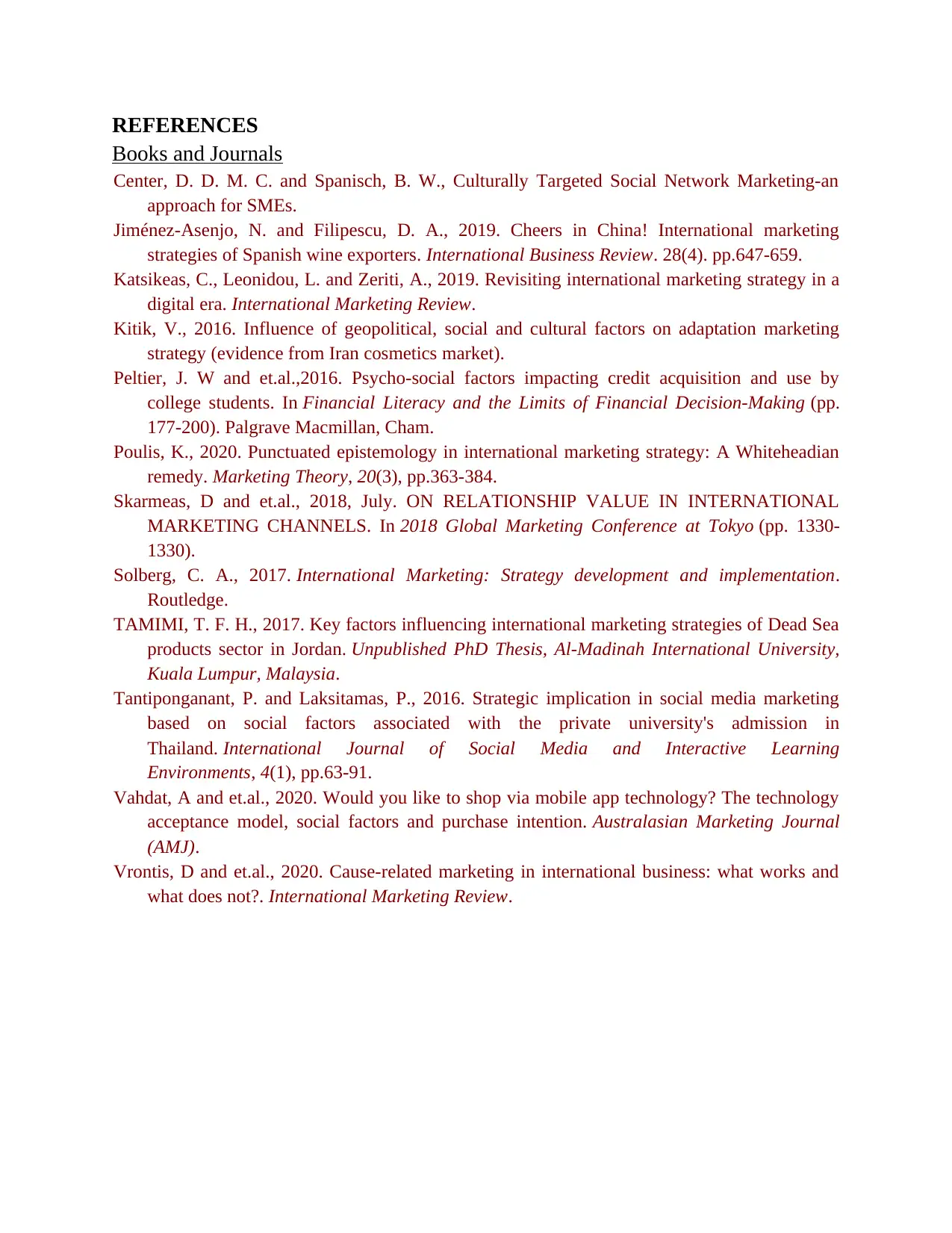
REFERENCES
Books and Journals
Center, D. D. M. C. and Spanisch, B. W., Culturally Targeted Social Network Marketing-an
approach for SMEs.
Jiménez-Asenjo, N. and Filipescu, D. A., 2019. Cheers in China! International marketing
strategies of Spanish wine exporters. International Business Review. 28(4). pp.647-659.
Katsikeas, C., Leonidou, L. and Zeriti, A., 2019. Revisiting international marketing strategy in a
digital era. International Marketing Review.
Kitik, V., 2016. Influence of geopolitical, social and cultural factors on adaptation marketing
strategy (evidence from Iran cosmetics market).
Peltier, J. W and et.al.,2016. Psycho-social factors impacting credit acquisition and use by
college students. In Financial Literacy and the Limits of Financial Decision-Making (pp.
177-200). Palgrave Macmillan, Cham.
Poulis, K., 2020. Punctuated epistemology in international marketing strategy: A Whiteheadian
remedy. Marketing Theory, 20(3), pp.363-384.
Skarmeas, D and et.al., 2018, July. ON RELATIONSHIP VALUE IN INTERNATIONAL
MARKETING CHANNELS. In 2018 Global Marketing Conference at Tokyo (pp. 1330-
1330).
Solberg, C. A., 2017. International Marketing: Strategy development and implementation.
Routledge.
TAMIMI, T. F. H., 2017. Key factors influencing international marketing strategies of Dead Sea
products sector in Jordan. Unpublished PhD Thesis, Al-Madinah International University,
Kuala Lumpur, Malaysia.
Tantiponganant, P. and Laksitamas, P., 2016. Strategic implication in social media marketing
based on social factors associated with the private university's admission in
Thailand. International Journal of Social Media and Interactive Learning
Environments, 4(1), pp.63-91.
Vahdat, A and et.al., 2020. Would you like to shop via mobile app technology? The technology
acceptance model, social factors and purchase intention. Australasian Marketing Journal
(AMJ).
Vrontis, D and et.al., 2020. Cause-related marketing in international business: what works and
what does not?. International Marketing Review.
Books and Journals
Center, D. D. M. C. and Spanisch, B. W., Culturally Targeted Social Network Marketing-an
approach for SMEs.
Jiménez-Asenjo, N. and Filipescu, D. A., 2019. Cheers in China! International marketing
strategies of Spanish wine exporters. International Business Review. 28(4). pp.647-659.
Katsikeas, C., Leonidou, L. and Zeriti, A., 2019. Revisiting international marketing strategy in a
digital era. International Marketing Review.
Kitik, V., 2016. Influence of geopolitical, social and cultural factors on adaptation marketing
strategy (evidence from Iran cosmetics market).
Peltier, J. W and et.al.,2016. Psycho-social factors impacting credit acquisition and use by
college students. In Financial Literacy and the Limits of Financial Decision-Making (pp.
177-200). Palgrave Macmillan, Cham.
Poulis, K., 2020. Punctuated epistemology in international marketing strategy: A Whiteheadian
remedy. Marketing Theory, 20(3), pp.363-384.
Skarmeas, D and et.al., 2018, July. ON RELATIONSHIP VALUE IN INTERNATIONAL
MARKETING CHANNELS. In 2018 Global Marketing Conference at Tokyo (pp. 1330-
1330).
Solberg, C. A., 2017. International Marketing: Strategy development and implementation.
Routledge.
TAMIMI, T. F. H., 2017. Key factors influencing international marketing strategies of Dead Sea
products sector in Jordan. Unpublished PhD Thesis, Al-Madinah International University,
Kuala Lumpur, Malaysia.
Tantiponganant, P. and Laksitamas, P., 2016. Strategic implication in social media marketing
based on social factors associated with the private university's admission in
Thailand. International Journal of Social Media and Interactive Learning
Environments, 4(1), pp.63-91.
Vahdat, A and et.al., 2020. Would you like to shop via mobile app technology? The technology
acceptance model, social factors and purchase intention. Australasian Marketing Journal
(AMJ).
Vrontis, D and et.al., 2020. Cause-related marketing in international business: what works and
what does not?. International Marketing Review.
1 out of 10
Related Documents
Your All-in-One AI-Powered Toolkit for Academic Success.
+13062052269
info@desklib.com
Available 24*7 on WhatsApp / Email
![[object Object]](/_next/static/media/star-bottom.7253800d.svg)
Unlock your academic potential
Copyright © 2020–2025 A2Z Services. All Rights Reserved. Developed and managed by ZUCOL.




